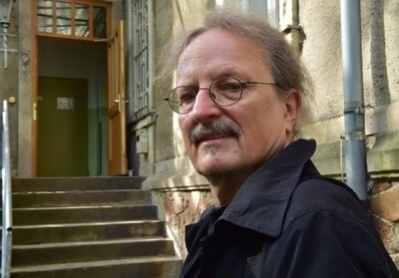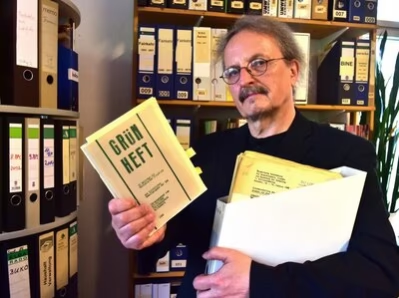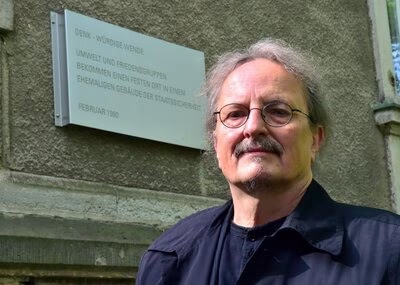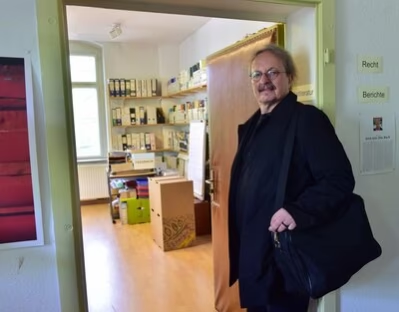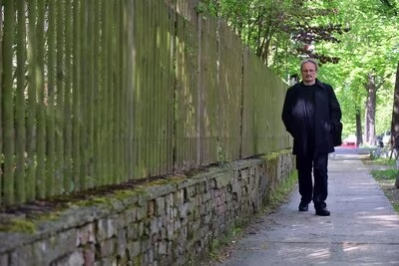Changes can be seen
Manfred Hastedt
Manfred Hastedt, head of the environmental centre, sits among folders and green plants. 25 years ago, after the peaceful revolution, his dream became a reality. He sat at the round table and was there from the very beginning of the Environmental Centre. To this day. After German reunification, Hastedt and his fellow campaigners focused intensively on the issues of ecology and international justice.
What was the decisive moment for you 25 years ago as to whether there could be an environmental centre in Chemnitz?
Manfred Hastedt: It was very moving that the concept for the environmental centre met with approval at the round table in February 1990. We didn't know at the time whether it would work. We were sitting in such a large group with citizens, representatives of parties and organisations. I was very pleased that we received support here.
We then had a look at the premises, Henriettenstraße. The Ministry for State Security, the Post and Transport Department, used to be based there. We were already practising ecology back then by adopting and reusing a lot of things: from paper clips to writing utensils. Incidentally, it was also the first MfS building to be handed over to the citizenry.
How did the environmental centre get started?
It quickly came to life: a carpooling centre, an organic food shop, Cafe Henri and the first world shop in Saxony. It was amazing how everyone pitched in. The rooms looked terrible and had to be renovated. We had to clear out everything. The people of Chemnitz showed their full commitment, organised everything, furnished the rooms and brought toys for our children's room at the time. In June 1990, there was a big street party to mark the official opening. Today, such a celebration is something quite normal, but for us it was all new.
Why was there so much interest in the environment in Chemnitz in particular?
It was similar in other big cities. Chemnitz is a city that is easily manageable. The people who are active know each other. And yet I was surprised at how many people we reached. Perhaps it has something to do with the fact that Chemnitz was one of the most polluted cities. We had very high levels of air pollution. There was no natural life at all in the Chemnitz river. In this respect, it is understandable that many citizens were concerned about improving the environment. There were church eco-groups here that were already dealing with ecological issues before reunification, had done the groundwork and were then able to act openly.
What did the Peaceful Revolution and reunification mean for the environmental movement back then?
What people had wanted for a long time could now be realised. At the time of the round tables, we couldn't even keep up with articulating our demands. One demand after another was met. Many things suddenly became a matter of course. And really: the environment has visibly improved. We have really clean air, clean water. Many things have improved. But today, of course, we have new environmental problems of a completely different nature. The challenges we face today are very different from those of 25 years ago. In times of climate change and development policy disruptions, the many different trouble spots around the world are challenging us. It's no longer just about the dirt on our own doorstep, but also about the problems when we look beyond our own backyard.
How does the Environmental Centre work today?
On the one hand, we have been supporting the Agenda21 citizens' process since 1998. We have a wide range of programmes for citizens who want to get involved in sustainable mobility, ecology and nature conservation, energy issues, changing values and development policy topics. We want to be a sustainable dialogue platform for society. Of course, we also provide information. This starts with children in day-care centres and, of course, with schoolchildren. We have a well-stocked environmental library with magazines and books on ecological topics. It is remarkable that the municipal employees and the associations are located in one building in the environmental centre. After reunification, this model was also new and interesting for western cities and abroad.
After 25 years, have you come to terms with your own history with the exhibition on church eco-groups? Was this an unknown chapter until now?
A lot can be forgotten in 25 years. In many cities, the activists have sat down and written books. In Chemnitz, the work of the church eco-groups was a blank spot. We didn't have time for it back then. I was a member of the first city council after reunification and helped set up the environmental centre. As a result, this reappraisal was lost. We didn't want to go down in the history books, we wanted to change the ecological situation. In retrospect, looking back is important for us because it shows what is possible. That you can achieve goals under difficult conditions and that social commitment is worthwhile.
What is your personal view of the city of Chemnitz?
I've lived in the city since 1976. Of course, I like the things that Chemnitz is rightly proud of: the Wilhelminian-style houses on Kaßberg and Sonnenberg, the art with the Chemnitz Art Collections and the Gunzenhauser Museum, the industrial architecture. The city simply has a lot to offer. Ecologically too: we have wonderful ecosystems and protected areas. Many people may not even realise that. We have orchid meadows in the city or a wonderful stand of old beech trees in the Zeißigwald forest. We are not far from the northern edge of the Ore Mountains and can reach a beautiful surrounding area in a short time.
Do you have a favourite place?
For me, it's the Zeißigwald. It's a very valuable old urban forest. We have a species-rich forest, not just a coniferous forest. There are beautiful paths. The Devil's Bridges have always been interesting for me. It's the region where the fossilised trees were found. And after a stressful day at work, the forest and nature are simply good for you.
Do you have to encourage the people of Chemnitz about your own city?
I think the city has great potential. We mustn't forget what the city has had to endure. The reunification meant a big break in economic terms, but the city is now showing positive development again. The gigantic changes over the past 25 years cannot be overlooked and should encourage everyone, and today there are many new sustainable initiatives by predominantly young people such as community solar plants, neighbourhood gardens, repair cafés, sharing and swapping projects and much more. Chemnitz offers good conditions for such projects, as there is plenty of room for manoeuvre.


